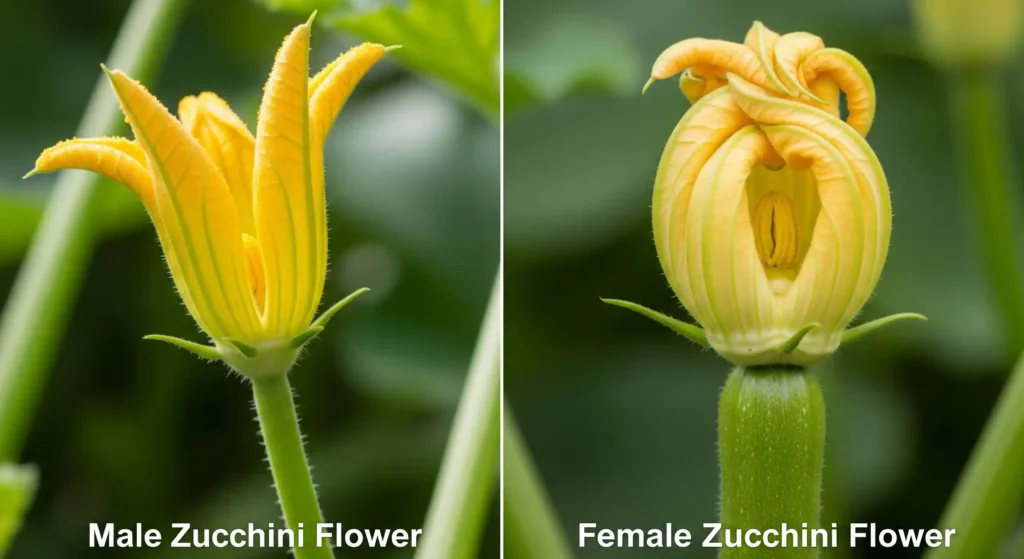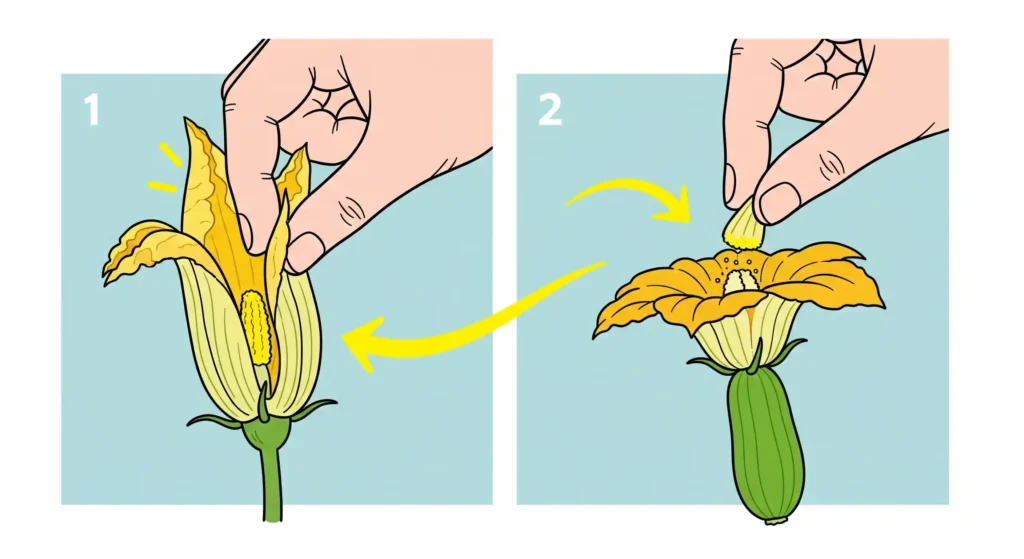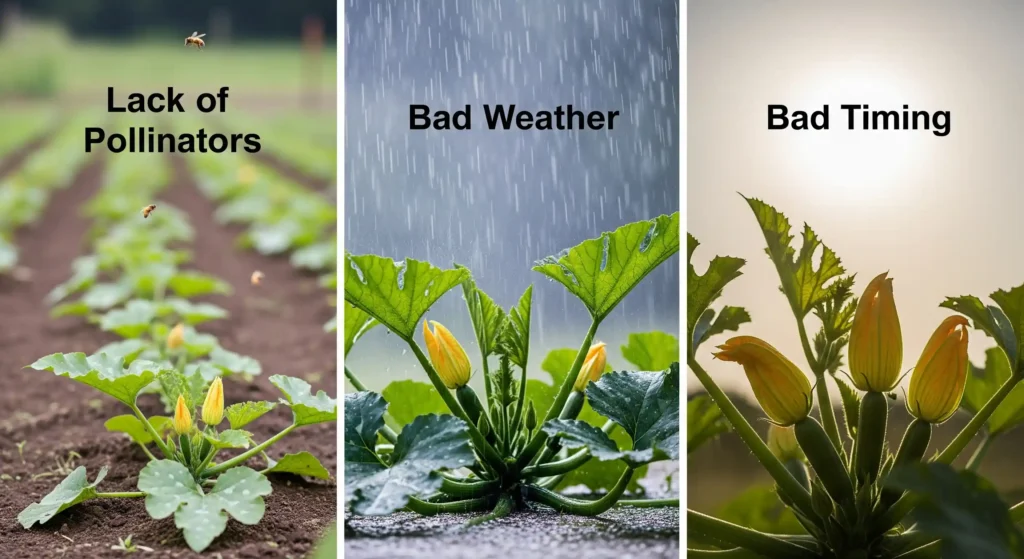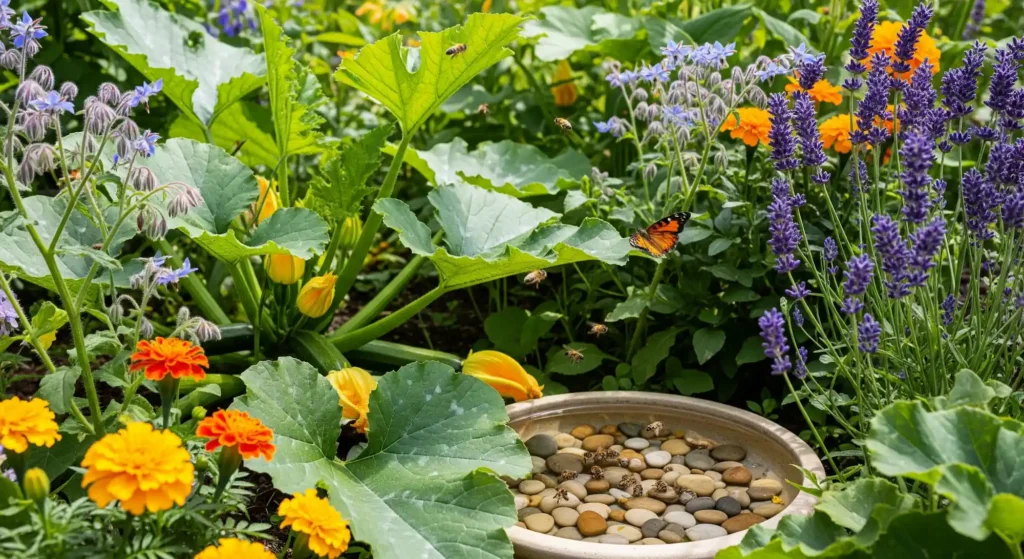Insufficient Pollination? Get More Zucchini Fruits Using These Pro-Proven Techniques
All summer you have been dreaming of delicious zucchini bread. You had visualized mountains of “zoodles” on your plate and grilled zucchini spears sizzling on the BBQ. You have been carefully watering, prepared the ground, and put the seeds—you have done everything perfectly. With its large, vivid leaves and consistent supply of gorgeous, brilliant yellow blossoms, your plant looks amazing, a spreading image of health. There is a drawback, though. Those blossoms are continually falling off; any small fruit that does show seems to wilt up and become yellow before it’s even bigger than your pinky finger. It is one of the most perplexing and annoying issues a gardener can run upon.
Have you ever considered why your neighbor’s zucchini plants are bursting while yours hardly yield? You are not by yourself in this annoyance. From my expertise tending to hundreds of gardeners, I can tell you that pollination issues are really common—and quite fixable. More usually than not, the problem is not your soil, your watering regimen, or the condition of your plant. In most failed zucchini harvests, inadequate pollination is the sad, simple cause.
The good news is that you are free to reject a fruitless fate. Knowing the basic science of zucchini reproduction and picking a few simple methods will greatly—and I mean greatly—raise your zucchini fruit output. Not to worry; you will soon learn the cause of this and precisely how to address it. With the correct information and a couple of these poor pollination zucchini fruit tips, you will transform from a disappointed gardener to a zucchini-harvesting champion.
The Birds and the Bees (and the Zucchinis): Understanding Zucchini Pollination
Watching those once-promising small fruits turn yellow and drop off is heartbreaking. To understand why this happens, we need to take a look at the love life of a zucchini plant. Solving your harvest problems depends on this intriguing tale.
The Science Behind Zucchini Reproduction
Your zucchini plant is what is known as “monoecious,” a fancy term meaning it produces separate male and female blossoms on the same plant. For a zucchini fruit to develop, pollen must be physically transferred from a male flower to the stigma of a female flower. Should this transfer fail or be insufficient, the female flower and its small, embryonic fruit will abort the mission, turn yellow, and fall from the plant.
Think of it this way: female flowers are the potential fruit factories; male flowers are the pollen providers. The male’s sole responsibility is to supply the pollen. The female’s mission is to gather that pollen and, if she is successfully pollinated, develop into a mouthwatering zucchini. The movement of this pollen is almost entirely the responsibility of pollinators, mostly our dear bees.
Common Reasons for Pollination Failure
So, what gets in the way of this vital connection? A number of factors can lead to zucchini pollination problems:
- Lack of Pollinators: This is a major issue, particularly in urban gardens or areas with low bee populations. If there are no bees visiting your garden, there’s no one to transfer the pollen from the male to the female blossoms.
- Bad Weather: Bees are fair-weather workers. They tend to stay in their hives during extended periods of rain, high winds, or excessive heat. If a run of bad weather hits just when your zucchini blossoms are open and receptive, pollination simply won’t happen.
- Bad Timing: A zucchini flower is the ultimate morning person. They open early, around daybreak, and often close up for good by midday on hot days. Most pollen transfer must happen in this brief window—roughly between 6 AM and 10 AM—when the pollen is most viable and the flowers are most receptive. If pollinator activity is low during these prime hours, you lose your opportunity for that day.
Playing Detective: How to Identify Male and Female Zucchini Flowers
The first step to taking matters into your own hands is learning to confidently tell the male and female flowers apart. It’s quite easy once you know what to look for, though beginners often confuse them at first.

Female Flower Features
The female blossom is the one with the potential to become a zucchini. Her most obvious characteristic is what she’s attached to. Look at the base of the bloom, where it meets the main plant stem. You will see a tiny, swollen green protrusion that looks exactly like a miniature zucchini. My grandma taught me a trick where the female flowers look like they are “already pregnant” with a zucchini. If you peek inside the golden flower, you’ll see a complex-looking center part called the stigma, which is often multi-lobed and has a slightly sticky surface, perfect for catching pollen.
Male Flower Features
The male flower has a much simpler construction. It grows on a long, straight, skinny stem with no swelling at the base. Its entire purpose is to produce pollen. Looking inside the blossom, you’ll find a single, straight stalk in the center called the stamen. This stamen is covered in the fine, golden-yellow powder you need—the pollen!
Simple Visual Checklist
- Female Flower: Has a small, bulging “baby zucchini” at its base. Center part (stigma) is complex and looks sticky.
- Male Flower: Grows on a long, skinny, straight stem. No swelling at the base. Center part (stamen) is a simple stalk covered in yellow pollen.
Playing the Bee: How to Hand Pollinate Zucchini for a Guaranteed Harvest
If you can confidently identify your male and female flowers, you are ready to play the bee! This technique is the number one way to guarantee a bountiful harvest. It’s simple, takes only a few minutes, and honestly feels a bit like magic.
Your Daily Pollination Ritual
Timing is everything. You must perform this task in the morning, ideally between 6 AM and 10 AM. This is when the flowers are fully open, the pollen is fresh and most viable, and the female stigma is at its most receptive. I’ll grab my coffee and walk out to the garden to check for any new blooms that have opened for the day, making it a quiet and immensely fulfilling way to start the day.

The Simple Hand Pollination Method
This is my favorite, low-tech method. It requires no special tools and is incredibly effective.
- Select a Healthy Male Flower: Look for a freshly opened male blossom. Gently holding the stem, carefully peel or snip off all the yellow petals, leaving only the pollen-covered stamen on its stalk. You have essentially created a perfect little pollen paintbrush.
- Find a Receptive Female Flower: Locate a female blossom that has also just opened that day.
- Transfer the Pollen: Using your male “paintbrush,” gently dab and swirl the pollen from its stamen all over the stigma in the center of the female flower. Be gentle but thorough. You want to see the yellow pollen dust clearly coating the stigma.
- Mark Your Success (Optional but Recommended): I like to loosely tie a piece of twine or string around the stem of the female flower I’ve just pollinated. This helps me keep track of which fruits result from my efforts and confirms that the technique is working when I see them start to swell and thrive!
Other Tools and Techniques
While the direct method is my preference, some gardeners prefer to use a tool.
- The Paintbrush Method: Select a small, soft-bristled artist’s paintbrush. Swirl it on the male stamen to collect pollen, then gently “paint” that pollen onto the female stigma.
- The Cotton Swab Method: A simple cotton swab works just as well. Use it exactly as you would a paintbrush.
I remember the first time I successfully hand-pollinated—seeing those tiny zucchini start growing instead of shriveling felt like I had unlocked a secret gardening superpower! One healthy male blossom has enough pollen to pollinate several female flowers, so you can move from one female to the next until you run out of visible pollen on your “brush.”
Troubleshooting Common Zucchini Pollination Problems
Even with hand pollination, you might run into a few issues. Don’t panic if you’re seeing these problems; every good gardener has been there, and there are solutions.

Help! I Only Have Male (or Female) Flowers!
This is extremely common, especially early in the season. Zucchini plants will often produce a wave of male flowers first, as if to “test the waters” before putting energy into the fruit-bearing female blooms. Sometimes the reverse happens. Be patient. The opposite gender will almost always appear within a week or two. If you have multiple plants, you may find one has male blossoms while another has females, so you can share the pollen between them.
“I Pollinated, But My Flowers Still Aren’t Productive!”
If you’re sure you’re pollinating correctly but the baby fruits are still withering, consider these factors:
- Extreme Heat: Temperatures consistently above 90°F (32°C) can destroy pollen, rendering it sterile and non-viable even with perfect transfer.
- Incomplete Pollination: The fruit may have been partially pollinated, but not enough to trigger full development. When hand-pollinating, make sure you cover all sides of the female stigma quite thoroughly.
- Plant Stress: A plant that is stressed from lack of water, nutrients, or disease may not have the energy to sustain fruit development and will abort them even if they are pollinated. Make sure your plant is well-fed and watered.
Calling Natural Pollinators to Your Garden
While hand pollination is an excellent technique, the ultimate goal is to create a garden that supports a healthy population of natural pollinators who will do the work for you. A garden humming with happy bees and butterflies is not only beautiful but also incredibly productive!

- Plant Companions: Interplant your zucchini with herbs and flowers that bees especially love. Borage, marigolds, lavender, bee balm, and cosmos are all excellent choices.
- Provide a Water Source: A shallow dish of water with some pebbles or marbles in it for bees to land on will make your garden a much more inviting place.
- Avoid Harmful Pesticides: Many pesticides are toxic to bees. If you must spray for pests, opt for organic solutions like insecticidal soap or neem oil, and always spray in the late evening when bees are not active.
Advanced Tips for Small-Space and Container Zucchini
Growing zucchini in pots presents unique challenges but is entirely achievable.
- Go Big: Zucchini are heavy feeders with large root systems. You need a large container—a 10-gallon pot is a good minimum, at least 18-24 inches wide and 12 inches deep.
- Choose Bush Varieties: Look for bush-type varieties specifically bred for containers, such as ‘Patio Star,’ ‘Eight Ball’ (a round zucchini), or ‘Astia.’
- Hand Pollination is Key: In a small space, you might only have a few flowers open at once. Hand pollination becomes absolutely essential to ensure every single blossom counts toward your harvest.
Frequently Asked Questions
How often should I hand pollinate my zucchini plants?
You should do it every morning that you have both male and female blossoms open. During the peak of the growing season, this is a daily task. Each blossom only lasts for one day, so you have to seize the opportunity when it presents itself!
Can I pollinate zucchini blossoms in the afternoon?
It’s not ideal. By the afternoon, most zucchini blossoms will have closed, and the viability of the pollen decreases significantly, especially in hot weather. Your chances of success are far, far lower than if you pollinate first thing in the morning.
Why do my zucchini start to grow then turn yellow and rot?
This is the classic sign of incomplete or failed pollination. The plant puts a tiny bit of energy into starting the fruit, but because it didn’t receive enough pollen to be viable, it aborts the fruit, which then rots and falls off.
How many male flowers do I need for good pollination?
One healthy male blossom produces a surprisingly large amount of pollen. Typically, a single male flower can successfully pollinate at least three to five female flowers.
Can I use a male flower from a different squash variety to pollinate my zucchini?
You certainly can! Zucchini, yellow squash, pattypan squash, and most pumpkins are all in the same family (Cucurbita pepo) and can cross-pollinate. So if your zucchini only has female flowers open but your yellow squash has males, you can use the pollen from your yellow squash to pollinate your zucchini.
How long after hand pollination will I see results?
You’ll know it worked very quickly! Within 24 to 48 hours, the base of the female flower—the tiny zucchini—will begin to swell and look visibly larger. If it begins to look dull or turn yellow, the pollination was unsuccessful.
Ultimately, Your Path to a Bountiful Harvest
It can be incredibly demoralizing when your garden doesn’t live up to your expectations, but as you’ve seen, the mystery of the barren zucchini plant has a very clear solution. By understanding the simple but critical roles of the male and female flowers and the pollinators that connect them, you can take control of your harvest. Whether you choose to attract more bees to your garden or take a paintbrush and a few minutes each morning to become the pollinator yourself, you now know how to solve the problem.
Seeing a fruit that you personally hand-pollinated develop into a beautiful, delicious zucchini is one of the great joys of gardening. By applying these pro-proven techniques, you can leave your frustrations behind and embrace an abundant harvest that will fill your kitchen with homegrown excellence all summer long.









